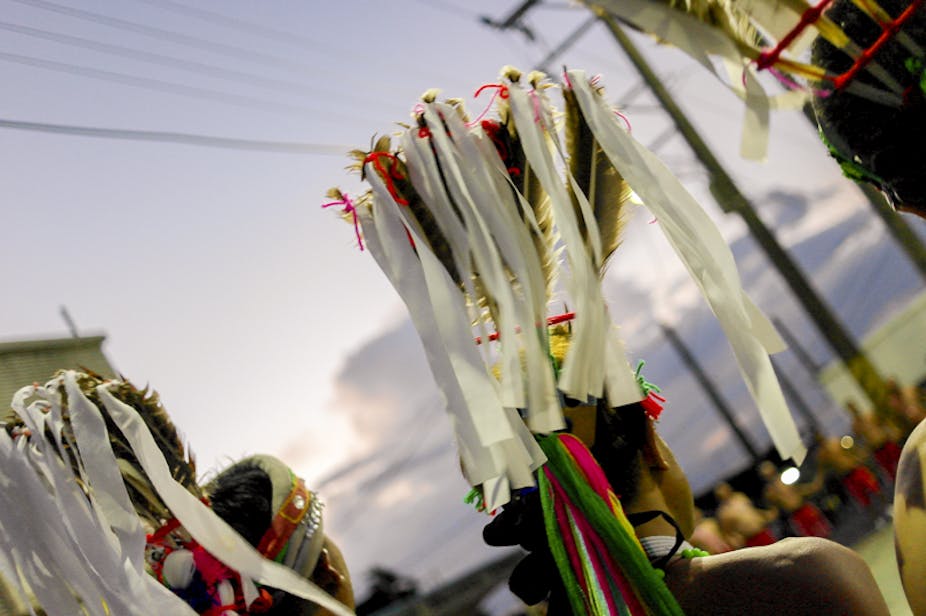How do we move beyond being a cultural tourist to having some deeper level of understanding of what local festivals mean to the people involved? That question has been on my mind of late.
Just before midnight on a recent summer evening, in a small village on the east coast of Taiwan, a crowd of men in a ritual circle began to dance and sing an ancient song. The sound of the men’s voices rang out over the sea and through the mountain forest behind, accompanied by the ringing of bells tied to the dancers’ legs. This ritual of song and dance continued for nine millet wine-fuelled hours, until long after sunrise. The women of the village watched from the sidelines, all through the night.
This was the opening night ceremony of the annual Ilisin ritual in one village of the indigenous Amis tribe of Hualien County. I was fortunate to attend as a member of a small group of researchers from my university in Taipei, some of whom attend this ceremony every year and have close links to the village people.
But the Amis people are not keen on having many visitors at their ceremonies, and I was warned that especially the younger folk can be less tolerant of those they see as mere tourists. They often don’t like to be filmed or photographed. For the Amis, their rituals are private village business.
Today, this brings many Amis people into open conflict with the Tourism Bureau of the ethnically Chinese government in Taipei, with local government in some areas. It also leads to tensions within village communities.
Cultural heritage versus the tourism industry

A few weeks ago, a group of Amis activists staged an invasive “tour” of the Tourism Bureau offices in Taipei, mimicking the behaviour of cultural tourists:
Wow, so this is what the Tourism Bureau people wear at work.
It was a clever PR stunt, but the issues are serious. Other minority groups in Taiwan have had their cultural traditions and sacred ceremonies appropriated and manipulated to serve the tourist industry. Now the Amis are fighting to safeguard what remains of their own heritage.
Interestingly, Amis society is matrilineal. A man is lower in status than his wife and his wife’s mother, and clan lineages pass through the female side of a family. Intersecting with this, the men are organised in strict age-set groups, each with particular responsibilities and regulations.
Amis religious beliefs were traditionally inextricable from these social systems, the political economy of social relations within the village, with neighbouring clans, and with the spirit world. In older times, Ilisin was a vital annual commemoration and renewal of contracts with ancestral spirits and powerful spirit-beings or gods. Within this context, it was also a time when a new chief might be chosen, when age-set groups might be promoted, and women might choose a husband.

Adding a layer of complication to understanding what Ilisin means today, the Amis people largely converted to Christianity after 1945. The majority are Roman Catholic, and the early Catholic missionaries encouraged the continuation of traditional ceremonies and even participated.
Presbyterian missionaries, on the other hand, forbade participation in such ceremonies and worked to undermine the traditional social structures. Because of these tensions, there are few villages today that can claim to have an unbroken tradition of Ilisin, and in many places the age-set and matrilineal inheritance systems collapsed decades ago.
The tourism industry exerts considerable pressure on indigenous people, through government policy and crude economics. Many groups have been encouraged to wear more outlandish costumes and to alter the dates and locations of festivals for the convenience of tour buses.
Some in the tourism industry have pushed for the Amis villages to gather together to celebrate Ilisin in bigger, concert-like gatherings at less remote places. This undermines many of the most important functions of such rituals, which are inherently local.
Some Amis also point out that the gods and ancestor-spirits of different villages often didn’t get along with each other, so celebrating a collective Ilisin must surely be a recipe for disaster.
Although I felt a little awkward as an obviously foreign observer at this important ceremony, quite a few village people chatted to me in English. They were curious to know where I was from and why I was there. Some kindly offered me betel nut.
We had to return to Taipei after two days, and typhoon Matmo was due to arrive that evening. One of the senior village men told us that the Ilisin ritual must continue regardless, and that they would dance and sing even in the typhoon.
Such determination in the face of disaster gives us some hope for the future of the Amis people and their valuable heritage.
*Please note, to protect the privacy of living Amis people, the author’s photographs do not show faces.

